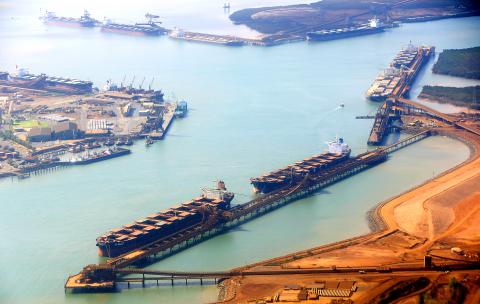Surging mining exports powered the Australian economy to better-than-expected 1.1 percent growth in the first quarter of the year, data showed yesterday, but Australian Treasurer Joe Hockey said he was also encouraged by a pick-up in other sectors.
The figures will come as welcome news for the government as a decade-long mining boom winds down, but analysts warned recent data point to weakness further down the line.
Annual growth was a seasonally adjusted 3.5 percent, the Australian Bureau of Statistics said, compared with analysts’ expectations of 3.1 percent. Markets watchers had expected growth of 0.8 percent in the three months to March.

Photo: Bloomberg
Hockey said while it was clear Australia relied heavily on its mining exports, the expansion in other sectors “show that the expected transition away from mining investment and construction toward other drivers of growth is underway.”
“This is an important indicator that the rest of the economy — the non-mining side of the economy — is starting to lift and that’s encouraging,” he added.
The Australian dollar rose by a third of a US cent to US$92.92 on the back of the figures, which followed a 0.8 percent expansion in the three months to December.
The mining sector made up 80 percent of growth in January to March, as net exports contributed 1.4 percentage points to the final figure. Consumption added 0.3 percentage points, but some of the gains were partially offset by inventories, which subtracted 0.6 percentage points.
Hockey said milder weather at the start of this year played a part in boosting exports.
“It’s an extraordinary quarter in March when you don’t have cyclones, particularly in Western Australia affecting Port Hedland, so our miners are exporting their socks off, and thank God because it’s having a positive impact on our economy,” he said.
However, he cautioned that “one swallow doesn’t make a summer.”
“The fact is that because we didn’t have cyclones in this March quarter, they dug deep into the inventories and as you can see, inventories detracted from the gross national expenditure in this quarter,” Hockey said.
ANZ senior economist Felicity Emmett said while the latest data was “a particularly good result,” it overstated the underlying strength in the economy as more recent data pointed to a slowdown in second-quarter growth.
“That is, retail sales data suggests that household consumption may slow further, while net exports are unlikely to make such a large contribution to growth,” she said. “Moreover, the drag from the wind-back in mining investment is likely to be sharper over coming quarters as large-scale LNG [liquefied natural gas] projects approach completion.”
AMP Capital chief economist Shane Oliver echoed her comments, saying it was “too early to break out the champagne” as he projected growth this quarter of just 0.5 percent.
“Mining export volume growth will slow down after the initial surge from new mine completions, consumer spending is likely to slow on the back of the [last month’s] budget’s short term hit to confidence and the further decline in the iron ore price will weigh on national income,” he said.

Six Taiwanese companies, including contract chipmaker Taiwan Semiconductor Manufacturing Co. (TSMC), made the 2025 Fortune Global 500 list of the world’s largest firms by revenue. In a report published by New York-based Fortune magazine on Tuesday, Hon Hai Precision Industry Co. (better known as Foxconn) ranked highest among Taiwanese firms, placing 28th with revenue of US$213.69 billion. Up 60 spots from last year, TSMC rose 60 places to reach No. 126 with US$90.16 billion in revenue, followed by Quanta Computer Inc. at 348th, Pegatron Corp. at 461st, CPC Corp., Taiwan at 494th and Wistron Corp. at 496th. According to Fortune, the world’s

NEW PRODUCTS: MediaTek plans to roll out new products this quarter, including a flagship mobile phone chip and a GB10 chip that it is codeveloping with Nvidia Corp MediaTek Inc (聯發科) yesterday projected that revenue this quarter would dip by 7 to 13 percent to between NT$130.1 billion and NT$140 billion (US$4.38 billion and US$4.71 billion), compared with NT$150.37 billion last quarter, which it attributed to subdued front-loading demand and unfavorable foreign exchange rates. The Hsinchu-based chip designer said that the forecast factored in the negative effects of an estimated 6 percent appreciation of the New Taiwan dollar against the greenback. “As some demand has been pulled into the first half of the year and resulted in a different quarterly pattern, we expect the third quarter revenue to decline sequentially,”

WEAKER ACTIVITY: The sharpest deterioration was seen in the electronics and optical components sector, with the production index falling 13.2 points to 44.5 Taiwan’s manufacturing sector last month contracted for a second consecutive month, with the purchasing managers’ index (PMI) slipping to 48, reflecting ongoing caution over trade uncertainties, the Chung-Hua Institution for Economic Research (CIER, 中華經濟研究院) said yesterday. The decline reflects growing caution among companies amid uncertainty surrounding US tariffs, semiconductor duties and automotive import levies, and it is also likely linked to fading front-loading activity, CIER president Lien Hsien-ming (連賢明) said. “Some clients have started shifting orders to Southeast Asian countries where tariff regimes are already clear,” Lien told a news conference. Firms across the supply chain are also lowering stock levels to mitigate

DIVERSIFYING: Taiwanese investors are reassessing their preference for US dollar assets and moving toward Europe amid a global shift away from the greenback Taiwanese investors are reassessing their long-held preference for US-dollar assets, shifting their bets to Europe in the latest move by global investors away from the greenback. Taiwanese funds holding European assets have seen an influx of investments recently, pushing their combined value to NT$13.7 billion (US$461 million) as of the end of last month, the highest since 2019, according to data compiled by Bloomberg. Over the first half of this year, Taiwanese investors have also poured NT$14.1 billion into Europe-focused funds based overseas, bringing total assets up to NT$134.8 billion, according to data from the Securities Investment Trust and Consulting Association (SITCA),